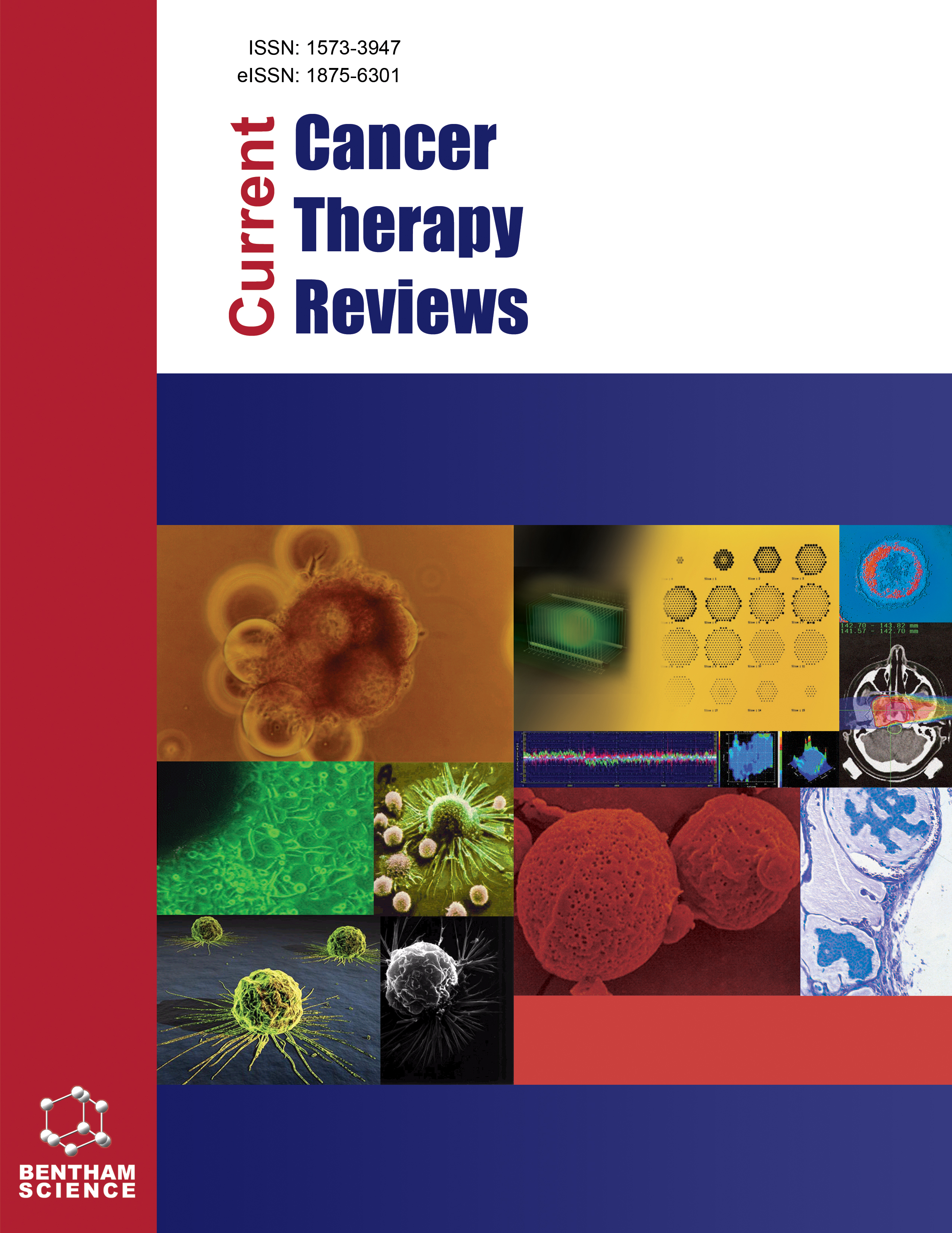- Home
- A-Z Publications
- Current Cancer Therapy Reviews
- Previous Issues
- Volume 15, Issue 3, 2019
Current Cancer Therapy Reviews - Volume 15, Issue 3, 2019
Volume 15, Issue 3, 2019
-
-
Immunology Behind Tumors: A Mini Review
More LessAuthors: Pooja Hurkat, Sourabh Jain, Richa Jain and Aakanchha JainBackground: The immune system is designed with great care to distinguish self from non-self, as exhibited by immune responses to different pathogens. Furthermore, the immune system has the capacity to distinguish between self from altered self in case of autoimmune diseases like cancer. Developing tumors bypass the immune system mechanism which restrains selfreactive responses. Immunotherapy is a coheren Read More
-
-
-
Anti-angiogenic Treatment in Metastatic Colorectal Cancer: Current Issues and Future Aims
More LessBlocking angiogenesis represents a fundamental process in Colorectal Cancer (CRC) treatment. VEGF (vascular endothelial growth factor) pathway is implicated in various processes that regulate tumor vascularization and proliferation. In the last years, great efforts have been made thanks to the discovery of targeted drugs that block VEGF and its receptors conferring a benefit in a variety of tumors, including CRC. To date, four Read More
-
-
-
Crocetin as an Active Secondary Metabolite of Saffron Stigma and Anticancer Effects
More LessAuthors: Ali Farahi, Homa Mollaei and Reyhane HoshyarIn order to try to increase the effectiveness of cancer therapeutic procedures, natural carotenoids attract lots of attention. Crocetin is one of the main carotenoids of saffron whose anticancer properties have been shown in recent decades. This study aimed to review previous in vitro and in vivo investigations on anticancer effects of this carotenoid and also proposed molecular mechanisms of its action. Literature reviewing b Read More
-
-
-
Efficacy and Safety of Targeting Androgen Receptor in Advanced Breast Cancer: A Systematic Review
More LessAuthors: Loay Kassem, Kyrillus S. Shohdy, Nafie F. Makady, Dalal S. Salem, Nadia Ebrahim and Mostafa EldalyBackground: Androgen receptor (AR) upstreams complex signaling pathways that regulate cell proliferation and contribute to breast tumorignensis. Several clinical trials were initiated to investigate the clinical relevance of targeting AR especially in hormone-receptor-negative breast cancer. Methods: The search was performed in PubMed and the meeting libraries of ASCO, ESMO, SABCS, ImpakT congresses from January 200 Read More
-
-
-
Main Nutritional and Environmental Risk Factors in Children with Leukemia from a Public Hospital of the State of Guanajuato, Mexico
More LessIntroduction: The prevalence of leukemia in children aged under 19 years continues to increase. Nutritional and environmental factors have been described as causes of their development, and maternal breastfeeding, birth weight, exposure to cow’s milk or to contaminants before 1 year of age, and smoking have been studied. Objective: To analyze the main nutritional and environmental risk factors in children with Acute Ly Read More
-
-
-
A Model for Heterogeneous Brain Tumor Cells that Cause Dizziness
More LessBackground: Various models are used for brain tumors modeling. To our knowledge, no earlier work has been done on modeling the heterogeneous brain tumor that causes dizziness. However, specifying a cell using a model is not new. Unlike all earlier works in this regard, which consider analog or analog-CPU computers in the cell model, the model presented in this work fully utilizes processor computers. Materials and Methods: Read More
-
-
-
Crocins: The Active Constituents of Crocus Sativus L. Stigmas, Exert Significant Cytotoxicity on Tumor Cells In Vitro
More LessBackground: Tumors of the childhood are considered to be grave and devastating pathologies, with high mortality rates. Current therapeutic options like cytotoxic drugs and radiotherapy target both healthy and malignant cells, thus resulting in long-term neurological and intellectual sequelae and endocrinological disorders. Objectives: In this study, we focused on the anticancer potency of crocins, the main constituen Read More
-
-
-
In Silico Analysis and Molecular Docking Studies of Novel 6,7-dihydropyrano [2,3-d] pyrimidin-5-one Derivatives as Human Epidermal Growth Factor Receptor 2 (HER2) and Epidermal Growth Factor Receptor (EGFR) Inhibitors
More LessAuthors: Ishan I. Panchal, Ashish Shah, Animesh Devgirkar, Umang Shah, Ashish Patel, Alkesh Patel and Dhrubo J. SenBackground: HER2 is a member of the human epidermal growth factor receptor (HER/EGFR-/ERBB) family. Amplification or over-expression of this oncogene has been shown to play a major role in the development and progression of certain destructive types of breast cancer. Several drugs like Trastuzumab, Pertuzumab, Capecitabine, and Letrozole are used in the patients with metastatic breast cancer that overexpress the HER Read More
-
-
-
The Cancer Hygiene Hypothesis: From Theory to Therapeutic Helminths
More LessAuthors: Ruben Fernandes, Helena Alves and Monica C. BotelhoBackground: The “Hygiene Hypothesis” was postulated by David Strachan in 1989 to explain for the rapid 20th century increase in allergic diseases such as asthma. In this hypothesis, children from developed countries living in ultra-hygienic environments and avoiding exposure to viruses, bacteria, and parasites, especially helminthes, have an increased risk of atopic disorders. Materials & Methods: Research and online con Read More
-
Volumes & issues
-
Volume 21 (2025)
-
Volume 20 (2024)
-
Volume 19 (2023)
-
Volume 18 (2022)
-
Volume 17 (2021)
-
Volume 16 (2020)
-
Volume 15 (2019)
-
Volume 14 (2018)
-
Volume 13 (2017)
-
Volume 12 (2016)
-
Volume 11 (2015)
-
Volume 10 (2014)
-
Volume 9 (2013)
-
Volume 8 (2012)
-
Volume 7 (2011)
-
Volume 6 (2010)
-
Volume 5 (2009)
-
Volume 4 (2008)
-
Volume 3 (2007)
-
Volume 2 (2006)
-
Volume 1 (2005)
Most Read This Month
Article
content/journals/cctr
Journal
10
5
false
en


